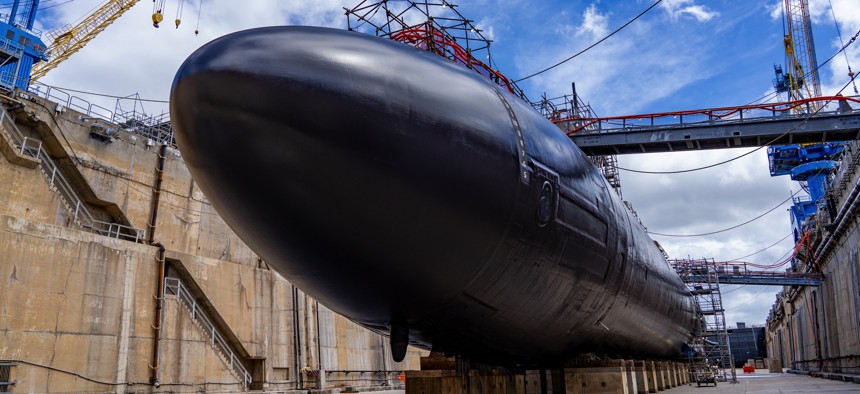
The attack submarine Topeka undocks—on time—after work at Pearl Harbor Naval Shipyard & Intermediate Maintenance Facility on July 27, 2021. U.S. Navy / Dave Amodo
Only Half the Parts Are Waiting When US Attack Submarines Come in For Repairs
The Navy’s attack-sub PEO has a plan to fix this, but he’ll need approval from higher-ups and the Hill.
When a U.S. attack submarine arrives for shipyard maintenance, Navy rules say the vast majority of the necessary parts and materiel must be there waiting. But most jobs actually begin with half or even fewer of the needed items on hand. That means delays, extra cost, and usually, stealing items from other projects, which compounds the problems across the sub force.
That's a planning and funding problem, according to the program executive officer for attack submarines, who says he's working to fix it by 2026.
“On the material side, we are not funding them properly…We do not fund the right amount and we do not phase it properly,” Rear Adm. Jonathan Rucker said Nov. 2 at the annual Naval Submarine League symposium in Arlington, Virginia.
The Navy has been struggling for years to get ships and submarines out of maintenance in a reasonable amount of time. In 2018, the Congressional Research Service calculated that such delays had cost the sub fleet more than 23 years of operational time. Chief of Naval Operations Adm. Mike Gilday made reducing delays and improving planning for heavy maintenance projects—”availabilities” in Navy-speak—a top priority in his 2021 Navigation Plan.
Currently, just 40 to 50 percent of the required parts and material are on hand when a sub arrives in the yard, Rucker said.
Part of the problem is that the Navy lacks funds for “contingent material”: parts to fix problems that are discovered during the work, like valves that are found to need replacement. But, Rucker said, these kinds of things are actually predictable.
“Every availability—about 90 percent—we use the same stuff. We know that, but we don't order it until then,” he said.
Because submarine parts are so specialized and the supply chain so constrained, this generally means the yard has to take the items from some other planned submarine-maintenance project, Rucker said.
“And with lead times of material on the order of up to two years and some more, no wonder we don't have the material we have to count on,” he said. “Because we order it after the avail starts, and we don't get it in time to do it, so we got to take it from somewhere else.”
Rucker said for new construction, the material is bought upfront. He wants to do the same for sustainment.
“So, we're changing that model so where we're going to phase the funding differently and order the contingent material in advance and so it's ready,” he said. “So when we get to that point, the stuff’s on the shelf. That's part of the problem of not buying all that stuff early on. Decisions were made early; we got to get after it.”
By 2026, each availability will start with the required 90 to 95 percent of the material on hand, he said.
But missing material is only part of what causes submarine-maintenance delays. Rucker said that planning and shipyard throughput are also causes for not “executing.”
Currently, the attack submarine force has about 1,100 days of maintenance delay, down from about 1,500 to 1,600 days in 2019, Rucker said, adding that improvements already in the works will reduce total annual delay days to 700 by 2026.
Late material adds 100 to 111 days of delay to each availability. These are the delays that better planning and funding is intended to reduce.
How the Navy could do this phased-funding approach is unclear. Rucker told reporters he is working to see which budget year to introduce it. When asked about the budgeting process for implementing something like this, officials with U.S. Naval Sea Systems Command and the Navy said they could not comment on internal budget deliberations or future budgets.
Bryan Clark, a senior fellow at the Hudson Institute and former submarine officer, said operations and maintenance funds are good for just the year it is appropriated but it can be extended when needed, and that usually only procurement accounts can buy material ahead of maintenance periods.
“I think Adm. Rucker is suggesting that Congress add funding to the [Other Procurement, Navy] account to support more advanced procurement of materials, parts and equipment ahead of maintenance periods, which normally Congress would say is ahead of need,” Clark wrote in an email. “These needs would need to go through NAVSEA and be incorporated into the Navy budget.”
He said another approach that has been discussed in Congress is to “create a more flexible maintenance appropriation that can pay for work or materials and be applied over multiple years rather than just one.” This type of appropriations could pay for both an overhaul’s material across several years and also the overhaul itself, Clark said.




